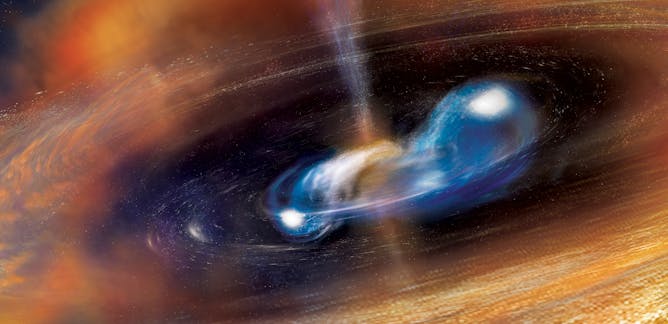|
|
|
|
The shocking collapse of NFL player Damar Hamlin during Monday’s Bills-Bengals game is raising questions about what could have caused his cardiac arrest after what looked like a routine tackle. Our breaking news editors contacted Dr. Wendy Tzou, the director of cardiac electrophysiology at The University of Colorado Anschutz Medical Campus, about what may have happened. Tzou explains how a blunt trauma to the chest during a particular moment in the heart’s electrical cycle can cause the heart to stop pumping blood in a condition called commotio cordis. Hamlin remains in critical condition and the cause of his collapse is still not known, but Tzou’s piece
provides excellent context for understanding problems related to arrhythmia in athletes.
Anyone who has worked in science journalism over the past few years cannot forget hearing the news that a scientist in China named He Jiankui had used the gene-editing technique CRISPR on human embryos, resulting in the first babies born with edited genes. Biomedical ethicist G. Owen Schaefer revisits this groundbreaking incident by reviewing a new documentary that provides deep background of the event, which led to worldwide condemnation and prison time for He. Schaefer writes that gene editing has valid medical purposes but explains why He’s widely criticized experiment continues to roil the frontiers of biomedical science.
Last week marked one year since the Marshall Fire raged through the Boulder, Colorado, area. A group of researchers from the University of Colorado Boulder write about their work examining how homes that survived may have been contaminated with indoor air pollutants caused by the burning of human-made material such as electronics and home furnishings. Although they still are conducting research, their work sheds light on the health risks that come with urban wildfires.
Also in this week’s science news:
If there's a subject you'd like our team of science editors to investigate, please reply to this email.
|

|
Martin La Monica
Director of Editorial Projects and Newsletters
|
|

Damar Hamlin, #3, collapsed on the field after making a tackle during a game on January 2, 2023.
Dylan Buell via Getty Images
Wendy Tzou, University of Colorado Anschutz Medical Campus
Disruptions to the electrical signals that control a person’s heartbeat are dangerous, no matter the cause. A heart doctor explains the biology of cardiac arrest and what might have happened on the field.
|

He Jiankui seemed unprepared for the furor set off by his bombshell announcement.
The He Lab/Wikimedia Commons
G. Owen Schaefer, National University of Singapore
Scientific and public uproar resulted when the Chinese scientist announced the births of the first human babies with heritable edits to their genes. A new documentary reexamines the saga.
|

Homes that survived the Marshall Fire didn’t come through unscathed.
Matthew Jonas/MediaNews Group/Boulder Daily Camera via Getty Images
Colleen E. Reid, University of Colorado Boulder; Joost de Gouw, University of Colorado Boulder; Michael Hannigan, University of Colorado Boulder
When the Marshall Fire swept through the Boulder suburbs, scientists began studying the health effects. What they’re learning could help homeowners in the future.
|
|
|

Andrew Bubak, University of Colorado Anschutz Medical Campus
People with an active case of shingles have up to an 80% higher risk of stroke than those without. The increased risk is highest for patients under 40.
| |

Roxanne Razavi, State University of New York College of Environmental Science and Forestry; Hadis Miraly, State University of New York College of Environmental Science and Forestry; Karin Limburg, State University of New York College of Environmental Science and Forestry
A new study shows that a time stamp can be put on mercury that accumulates in fish eyes, offering a window into their lifetime exposure.
|

Michael R. Hudec, The University of Texas at Austin
When mud, fluids and gases erupt at the Earth’s surface, they hint at what’s happening underground, allowing scientists to build a more comprehensive 3D view of what’s going on inside our planet.
| |

Anne R. Crecelius, University of Dayton
Tiny fluctuations in the time between each beat of your heart can provide clues about how much stress your body is experiencing.
|

Talia Dan-Cohen, Arts & Sciences at Washington University in St. Louis; Carl Craver, Arts & Sciences at Washington University in St. Louis
Astrology and astronomy were once practiced side by side by scientists like Galileo and Kepler. And they’re more similar than you might think.
| |

Eleonora Troja, University of Rome Tor Vergata; Simone Dichiara, Penn State
Gamma-ray bursts occur when a massive star explodes or when two neutron stars merge. A newly discovered burst has puzzled astronomers, as it lasted much longer than astronomers would have expected.
|

Bhavana Patel, University of Florida; Torge Rempe, University of Florida
Although there is no cure for this disorder, there are treatments that can help alleviate symptoms.
| |

Hong Liu, Florida International University
Dendrobium orchids are familiar to most people in bouquets, but they are in high demand in China for use in traditional medicines. Can Beijing find ways to grow these threatened plants sustainably?
|
|
|
|
|
-
Erika Bocknek, Wayne State University
Sound sleep, for long enough every night, with consistent bed and wake-up times are critical for kids’ health. A child development expert suggests some overarching tips to help get you there.
-
Alexander (Sasha) Poltorak, Tufts University; Hayley Muendlein, Tufts University
An overactive immune response to infection can be deadly. Studying how one key player called tumor necrosis factor, or TNF, induces lethal immune responses could provide new treatment targets.
-
Rachel Kyte, Tufts University
Look for significant progress in 2023 in two key areas, writes a veteran of international climate policy.
|
|
|
| | |
| | |
| |
| |
| |
|
|
|